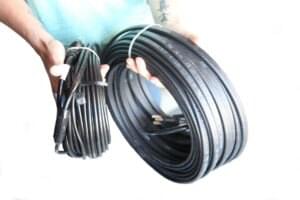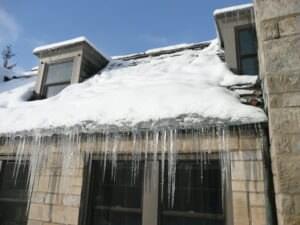The Advantages and Disadvantages of Using Heating Cables
Cold weather can pose some problems for homeowners. Mainly, homeowners tend to struggle with ice dam remediation.
Ice dams occur when the ice and snow at the peak of your roof melts and refreezes towards the base of your roof. As the cold weather continues, more ice will accumulate and can creep up your roof.
Ice dams can lead to leaking, as the ice can get under the shingles and find nail holes.
If you have noticed a massive pile of ice and snow on your roof during the winter, you are not alone. In the ten years Rescue My Roof has been in business, the number one topic we get calls about in the winter is ice dams.
We have worked with clients just like you who are stuck on how to decrease the size of the ice dams overtaking their home’s roof.
Ice dam remediation can be costly, especially if you have to call in a professional every winter. That is why heat cables might be the best option for you.
In this article, you will learn about what heat cables are and the benefits and drawbacks of using them on your home. By the end, you will know whether this is the option to tackle ice dams during the winter.
The Benefits of Using Heating Cables

If you are looking for a cheap option to help combat ice dams, heating cables might be the right fit.
Here are some of the benefits of using heating cables during the winter:
1. Heating Cables Help Mitigate Ice Dams

Ice dams can be a homeowner’s arch-nemesis during the winter. However, if you are at a loss of how to melt ice dams without the help of a professional, heating cables can come in handy.
Heating cables plug into a standard electrical outlet and can wrap around your roof. The cables heat up enough to melt the ice in the areas they are placed.
If you notice a ton of ice built up in a particular area, you can place heating cables there to help melt down the ice dam.
If you know your home struggles with ice dams in the winter and don’t want to call out a professional several times a season, using heating cables to mitigate ice dams might be a good idea.
2. Heating Cables are Less Expensive than the Professional Alternative
Heating cables are a good option for those who want to save money. Heating cables are relatively inexpensive, ranging from $20-$100, and easily accessible at most stores that sell tools and hardware.
Calling a professional to use a steamer to melt the ice can cost upwards of $100/hour, plus materials. And depending on how severe the ice dams are, the work can take 2-4 hours.
Additionally, investing in heating cables is less costly than other options like energy audits and air sealing. An energy audit is when a professional uses an infrared thermometer to see the extreme hot and cold spots in your attic space to see if you have enough ventilation.
An energy audit also includes sealing up any area that allows drafts into your home for more efficient heating and cooling.
By using heating cables, you are saving on the costs of having a professional come out and do an energy audit or remediate the ice dams themselves.
If you have a strict budget and are up to the challenge, heating cables would be a good fit for you.
3. You Can Install Heating Cables by Yourself
If you’re a fan of DIY projects and don’t want to spend money on a roofing professional, heating cables are easy to install on your own.
After identifying the areas in significant need of ice dam remediation, you can use a ladder to place the cables in the specified areas.
It’s a low-hassle option to combat ice dams, and you don’t have to be a roofing expert to do it.
The Problems with Heating Cables
As with everything, there are pros and cons to heating cables.
Here are some of the drawbacks if you choose to install them:
1. You Cannot Use them to Prevent Ice Dams
If you already struggle with ice dams, heating cables can certainly be used to help melt them.
However, they will not prevent ice dams. The best method for preventing them and ultimately preventing the damage they will cause to your roof is to have adequate ventilation and do an energy audit.
Both of those options may be more pricey than the heating cables. So if you want to stick to a strict budget and risk the potential damage, heating cables may work for you.
2. Higher Energy Bills
This seems counterintuitive, as ice dams are supposed to cause higher energy bills, and you’re getting rid of them, right?
Unfortunately, that’s not the case. Heating cables plug into a standard electrical outlet. If you have to leave them running for most of the season to combat the constant ice, then you will see an increase in your energy bills.
How much of an increase you will face is unknown. However, it could potentially be the same as professional ice dam remediation or the cost of doing an energy audit.
Be aware of energy costs in your area before investing in heating cables, as the price may not be worth it.
3. Heating Cables Can Put a Damper on Your Home’s Curb Appeal

Heating cables aren’t the prettiest invention. While they can effectively remove ice dams, they aren’t going to add any charm to your home.
If you highly value your home’s curb appeal, or maybe you are selling your home soon, you might not want heating cables in the picture.
4. Heating Cables Could Be A Fire Hazard
According to the Consumer Product Safety Commission (CPSC), heating cables can be a fire hazard.
The CPSC recommends that homeowners inspect their cables annually to ensure they don’t pose a threat.
Approximately 3,300 residential fires involve heating cables or tape each year, and it’s better safe than sorry. Inspect your cables thoroughly before use to keep your home and family safe.
Should I Use Heating Cables for Ice Dams?
The answer depends on your circumstance. If you have a low budget, don’t have too much trouble with ice dams each year, and don’t mind their appearance, then heating cables may be for you.
However, suppose you want to go with the safest and most effective method of ice dam remediation and call a roofing contractor. In that case, you may save on energy costs for the season and avoid the potential fire hazard.
Expand your roofing education with “The Differences Between Winter and Summer Roofing” and “Preparing Your Roof For the Winter.”
If you live in the greater Milwaukee area and have decided that professional help is the best fit for you, contact Rescue My Roof today to book a free estimate.

